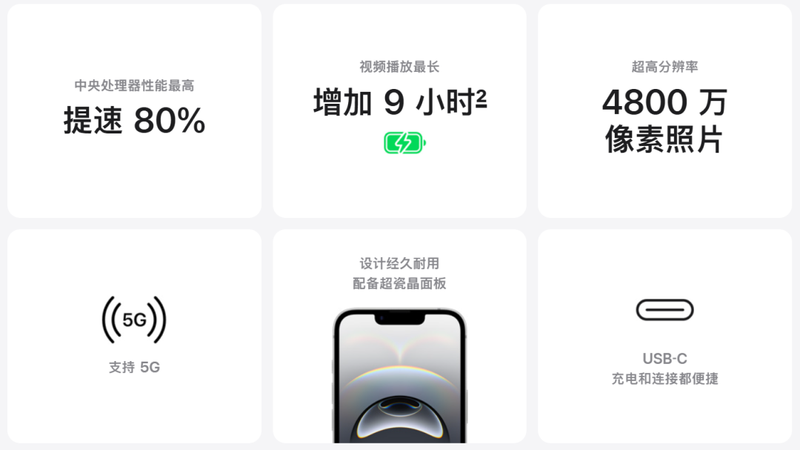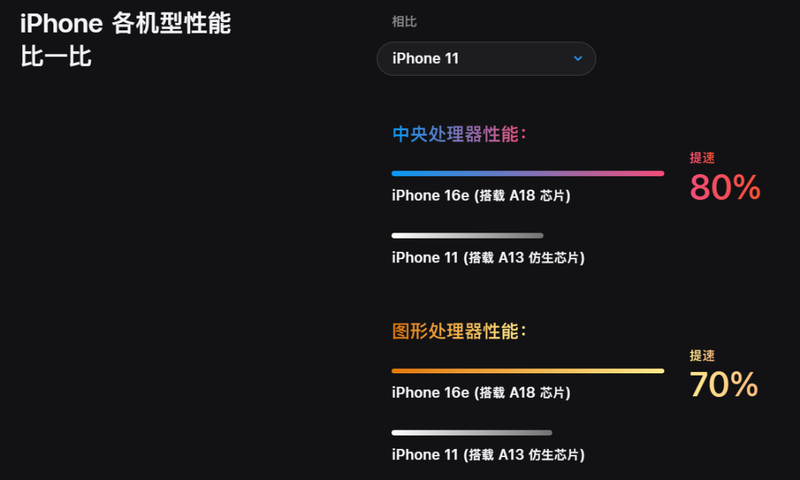The market is picking up, but Apple is still out of winter
Apple is stuck with the cheap card
Author 丨 Snow Leopard Financial Society Han Xing
The iPhone, which has been cutting prices frequently in recent months, has once again played a low price card. Three years later, Apple has returned to its cheap product line SE, but it is somewhat secretive.
In the early morning of February 20, Apple launched a new product, iPhone 16e, on its official website, priced at 4499 yuan.
Although the new product is not named after SE, its design style and functional matching are exactly the same as the iPhone SE4 previously revealed, except with a different name.
If you look at the pricing rules for digital series models that have been in use since 2019, this is the cheapest iPhone ever in Apple’s digital series. But if you think of it as the fourth-generation iPhone SE, it is the most expensive one among them.
Can this low-priced card, which is both important and important, save Cook from the sales dilemma?
Cheap cards, but not cheap
Unlike previous spring products that were quietly launched, this time, Cook announced new members of the Apple family on social media five days in advance.
From the appearance point of view, the iPhone 16e abandons the classic design of the Home physical button and thick border that previous SE models have always retained, and completely enters the era of full-screen. However, the front still adopts bangs design and does not carry Lingdong Island.

Source: Apple official website
The back of the phone continues SE’s single camera design with 48 million pixels, the same as the iPhone 16.
The new machine uses the same A18 chip as the iPhone 16, but one less GPU chip. On Apple’s official website, the default comparison models for the iPhone 16e are the iPhone 11 released in 2019 and the iPhone 12 released in 2020.

Performance comparison of default models on official website Source: Apple official website
Equipped with the A18 chip, it also means that the iPhone 16e has reached the threshold of Apple Intelligence and is currently Apple’s cheapest AI smartphone.
Compared with the latest AI phones from other Android manufacturers, the price of 4499 yuan has certain advantages. The starting prices of new AI phones launched by Xiaomi, OPPO, vivo, and Glory last year are: 4999 yuan (Xiaomi 15), 4799 yuan (OPPO FindX8), 4699 yuan (vivo X200), and 4499 yuan (Glory Magic 7).
In addition, another feature that distinguishes this iPhone from other Apple products is that it is the first product to be equipped with Apple’s self-developed 5G baseband (modem).
Apple has always hoped to be able to independently develop core components. Since 2017, it has had the idea of developing its own baseband, but the process has not been smooth. The iPhone 16 and iPhone 16 Pro released in September last year did not carry the self-developed 5G baseband as expected, but were delayed to the iPhone 16e.
As a new cheap iPhone, the 16e has no functional innovation, and cheapness is still its core selling point.
Compared with the previous three generations of SE models, the pricing of the iPhone 16e has further improved, but it is still 1500 yuan lower than the starting price of the iPhone 16 standard model, which is significantly different from the flagship models on sale.
In the past six months, keywords such as low price and price reduction have been tightly tied to the iPhone. ldquo; iPhones at cabbage prices are nothing new to China consumers.
In January this year, Apple’s official website officially announced a New Year’s promotion, lowering the price for the just-released iPhone 16 series for the first time, with a maximum drop of 500 yuan. In the earlier Double 11 promotion, the iPhone 16 has already experienced a round of price reduction promotions in various channels, including Apple’s own official Tmall flagship store offering a discount of 500 yuan.
Less than four months after the new machine was released, official channels have twice been promoting price cuts in a row, which is rare for the iPhone.
The market is picking up, but Apple is still out of winter
After three years, Apple’s motivation to reintroduce cheap models is obvious to boost iPhone sales.
In the latest financial report released for Q1 for fiscal year 2025 (Q4 for natural year 2024), although Apple’s revenue for the quarter broke the historical record since its launch, reaching US$124.3 billion, it mainly benefited from software services and hardware such as iPads and Macs. Increase in revenue.
As Apple’s financial pillar, iPhone sales fell 0.8% year-on-year to US$69.1 billion during the reporting period, lower than market expectations. According to IDC, shipments of the global smartphone market in Q4 in 2024 increased by 1.7% year-on-year, but Apple fell by 4.5% during the same period, and its market share also shrank by about 1%.
What worries Apple even more is that in China, one of the world’s major markets, iPhone sales continue to be sluggish.
In Q1 of fiscal year 2025, Greater China is the third largest source of revenue for the iPhone. Revenue during the period was 18.5 billion yuan, a sharp drop of 11% year-on-year, lower than market expectations of 21.3 billion yuan. It is also Apple’s only global sales decline. region.
Cook said at the earnings call that reasons for the decline in sales include Apple’s failure to launch the artificial intelligence service Apple Intelligence in the market and the impact of changes in channel inventory.
The decline in iPhone sales in China has led to the gradual demise of the once-popular scalper business. After the launch of the iPhone 16, the premium time for the new machine dropped significantly compared with previous years. The profit of some scalpers from reselling an iPhone 16 was only around 200 yuan, which was only 5% to 6.7% of the profit of the iPhone 4 14 years ago. A large number of scalpers started shipping at a loss within a week after the new machine was launched.
The price issue that Cook did not mention but Apple frequently attempts to solve with practical actions is another factor that cannot be ignored.
In the past year, the global smartphone market ended its two consecutive years of decline, with annual shipments increasing by 7% year-on-year to 1.22 billion units. Among them, it is not high-end machines that contribute the main growth driving force.
According to TechInsights statistics, the main driving force for the recovery of the mobile phone market in the first half of last year was the significant increase in demand from emerging markets, including central and eastern Africa, Latin America and the Asia-Pacific region. In these regions, the most popular are lower-priced entry models, including Samsung’s low-end A-series, Red Rice and Motorola’s G-series, with average selling prices mostly below US$400, or less than RMB 3000.
Against this backdrop of global demand, a cheap model that sells for around $400, has most of the iPhone’s features, and can use Apple Intelligence and enjoy the iOS ecosystem may have the best time to go public.
Guojin Securities Research News predicts that if Apple releases the SE4 in the spring of 2025, its annual sales are expected to reach 20 million units. According to Canlys statistics, in 2024, the total shipment of the full range of iPhone models will be approximately 226 million units.
Based on the above data, if the iPhone 16e can sell 20 million units as expected, it will bring at least an 8.8% increase in iPhone sales.
Sell more, or sell more?
This is not the first time that Apple has pinned its hopes of saving iPhone sales on low-priced brands.
In the second quarter of fiscal 2016, Apple’s revenue and profits both fell, mainly due to the sharp decline in iPhone sales. This is also the first revenue decline since Apple went public. At that time, Apple’s CFO attributed the reason to a decline in user demand for upgraded equipment after a wave of iPhone replacements.
Not long after, the first-generation iPhone SE came out. It was the first new product Apple launched for the mid-market. It looked similar to the iPhone 5s released more than two years ago, but it was equipped with the latest A9 chip of the year. Through this old bottle, the new wine method reduced the price of the iPhone by nearly 50%.
However, the initial iPhone SE for the mid-market did not significantly boost iPhone sales. According to statistics from Counterpoint Research, the original iPhone SE was sold from March 2016 to September 2018. In two and a half years, approximately 31 million units were sold, with an average annual sales of approximately 12.4 million units. Global iPhone shipments in 2018 were 217.7 million units.
What really helps Apple get out of the sales quagmire is not to sell more, but to sell more expensive.
In September 2017, Apple released the iPhone X, which for the first time increased the price of the iPhone’s flagship model to $1000. In the first fiscal quarter after the launch of iPhone X, iPhone sales still fell by 1% year-on-year. However, due to the increase in average selling price, sales increased by 13%, and the double-digit growth rate remained for three consecutive quarters. As sales picked up, Apple’s market value also exceeded US$1 trillion the year after the iPhone X was launched.
In contrast, Apple’s SE2 and SE3 launched in 2020 and 2022 respectively have not caused too much waves in the market. According to Counterpoint Research, sales of the second and third generation iPhone SE are lower than that of the original generation, and the SE3 accounts for less than 1% of total iPhone sales.
Buying an iPhone with relatively backward performance at a lower price obviously cannot impress most consumers.
This also puts Apple in a dilemma: the performance is too poor to impress consumers; the performance is too strong, and it will impact its flagship model. This contradiction makes SE a useless product.
In addition, consumers lack the power to buy new machines, and price is not the only factor. The iPhone, which has always been positioned and firmly occupies the high-end mobile phone market, has been criticized by consumers for its lack of innovation rather than its high price.
In recent years, due to the homogenization of smartphone functions, the replacement cycle for global users has become longer and longer, reaching 43 months in 2022 and is still growing. Facing increasingly fierce competition from local brands in the China market, the appeal of the iPhone, which has been unable to produce new things, is also declining.
The iPhone, which has been forced to start pricing, may not be able to find a new path with this move.
It is not allowed to reproduce at will without authorization, and the Blue Whale reserves the right to pursue corresponding responsibilities.



